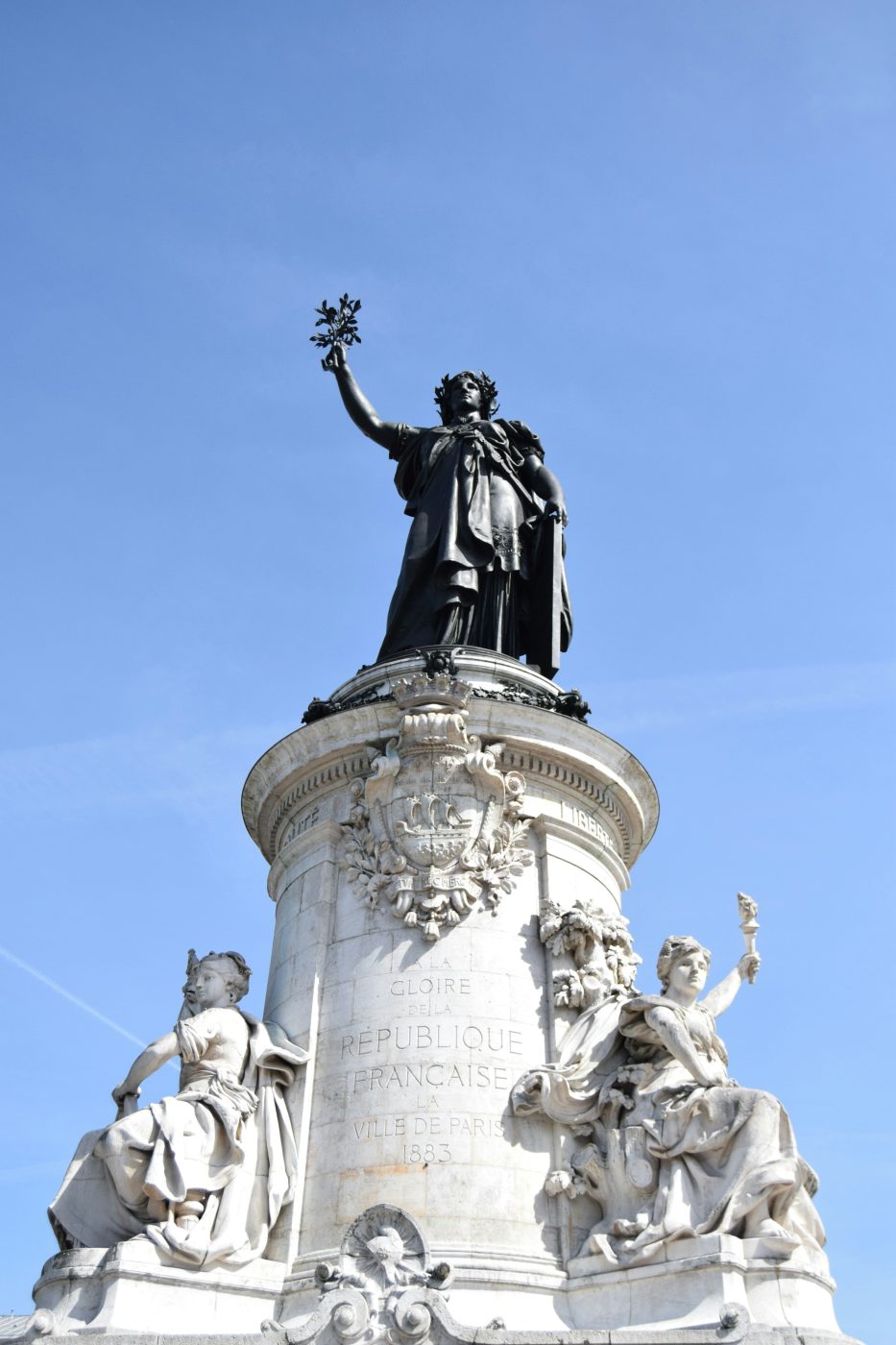
From Place de la République in Paris to the streets of London, national symbols are once again taking center stage in European demonstrations. Flags, anthems, historical references — all those elements that once united citizens have now become contested ground, at the heart of an identity and cultural struggle. In France, as elsewhere, they reveal the increasingly fragile line between patriotic attachment and nationalist temptation.
In Paris, the Republic Draped in Tricolor
On Sunday, October 12, several hundred people gathered at Place de la République¹ waving French tricolor flags. The demonstration, organized at the call of influencer Ben le Patriote — a promoter of nationalist ideas with more than 360,000 followers on Instagram — and the association Les Patriotes de la diversité, aimed to cover the iconic Parisian square in French flags.
In a video published by the media outlet Frontières, one participant declared she was there “to defend our France, which really needs it. To defend the values of our France,” before adding, “All French people should be here.” It was a citizen-led, non-partisan gathering that took place peacefully — yet its main demand was striking: to restore French symbols to the heart of public life.
While some proudly waved the tricolor flag, others wore the bonnet phrygien, the red cap of the Revolution; one man even displayed the Cross of Lorraine, a symbol tied to the Gaullist era. “There’s a real problem in schools,” one participant claimed. “We should, at least once a week starting in primary school, raise the flag and sing La Marseillaise.”
“Banal Nationalism,” or the Quiet Power of Symbols
A member of the European Left Party, a group represented in the European Parliament by members from various left-wing factions, spoke on condition of anonymity. Across from his home, during the 2018 World Cup, a supermarket had draped its façade with a massive French flag, while the aisles were filled with tricolor products — makeup, scarves, and various gadgets. For him, this “commercialization of blue, white, and red” illustrates the emergence of “banal nationalism”, in the sense described by British political scientist Michael Billig²: a diffuse, subtle form of nationalism that manifests less through speeches than through familiar signs — identity documents, war memorials, school anthems, flags displayed in windows.
These visual and ritual reminders, often perceived as natural or neutral, foster a sense of national unity while quietly shaping the boundaries of collective belonging. In the context of political polarization within European societies, however, they can take on a political charge: being “patriot” or “globalist,” “friend” or “foe.”
The activist emphasizes that a national symbol, intended to unite, can also become an implicit marker of inclusion or exclusion. The power of “banal nationalism” lies precisely in its banality: through the repetition of signs and gestures, it embeds the nation into daily life, nurturing cohesion that, depending on the context, can serve either as a tool of unity or a source of division.
Memory and Symbols: Comparing France and Spain
This tension between national attachment and European openness also resonates with younger generations in other European countries. Julia Gonzalez Ruiz, a student at Sciences Po originally from Madrid, explains that, as she experienced it, Spanish nationalism often operates to the detriment of other European nationalities. She notes that, particularly among the most conservative segments of society, “there is still a lingering hostility toward our French neighbors, for historical reasons, mainly related to Napoleon’s invasions of 1807–1808, seen as the end of a golden age for the country.”
Having lived in Paris for two years, Julia points out that nationalism functions differently on either side of the Pyrenees. She observes a greater manipulation of national symbols in Spain than in France, with the national flag systematically appropriated by the VOX party, alongside the persistent veneration of certain Franco-era sanctuaries. “We try to reclaim this symbol, which belongs to all Spaniards, but there is always a fear of being accused of supporting the nationalist right.”
She recalls that the 1977 amnesty laws, adopted after Franco’s death, were enacted at the expense of a genuine construction of national memory: “There has been a real problem of memory since the establishment of democracy in Spain.” As historians Santos Juliá3 and Paloma Aguilar Fernández⁴ have shown, this policy left symbols in the public space that were never fully reinvested under democracy, alongside a lingering sense of injustice among the victims of Francoism.
Julia emphasizes that, by contrast, in France, the memory of Pétain remains distant, and the Marshal’s figure has never been integrated into contemporary patriotic rhetoric. While the Vichy regime still belongs to collective memory, it has not become a symbol of unity or national pride — which can largely be explained by the fact that Pétain was tried and convicted for his crimes in 1946. The tricolor flag, by contrast, has retained its republican significance, even if some political currents seek to imbue it with an identity-based dimension.
For many citizens, the challenge therefore lies in reclaiming these symbols in a way that reconciles national pride with democratic openness.
Lessons from the Spanish Model: The Role of Regions in Weakening Nationalism
This dynamic was also evident in discussions the European Left Party activist held with engaged Spaniards during a forum. According to him, regional identities have shaped the relationship to the nation. In Spain, the “battle against fascism”, according to his words, was long fought at the regional level: the Socialist Party of Catalonia and the various regional branches of the Communist Party demonstrate how local political diversity served as a bulwark against the centralism imposed by Franco.
Communist and Socialist parties often adapted their names and organizational structures according to the territories, reflecting both strategic flexibility and a desire to build autonomous political spaces while remaining united against authoritarian ideologies. As the sinologist and essayist Jean-François Billeter⁵ noted, “the best way to combat nationalism is undoubtedly to develop the regional and European dimension.”
This idea resonates particularly with the European Union’s regional support policies, where strengthening local identities could help ease nationalist tensions. For instance, in January 2022, the Committee of the Regions and the European Commission signed a joint action plan to ensure that EU regions can fully benefit from the massive investments of the cohesion policy. The goal: “to promote cohesion as a fundamental value and as a guiding principle for all EU policies.”
A Nationalism That Has Become Transnational
In France, the relationship between regionalism and nationalism remains more ambiguous. Regionalism has long blended left- and right-wing traditions — from Breton nationalists to Occitan movements — without forming a clear front against the central government.
“We are very far from the English,” remarked a demonstrator at Place de la République, referring to the September 14 protests in London, where over 150,000 people gathered around the nationalist figure Tommy Robinson, known for his anti-immigration stance and his rhetoric against the “globalist elite.”
This comparison, made with a tone at once admiring and critical, speaks volumes about the circulation of nationalist models across contemporary Europe. While these movements each claim a strong national identity, their forms of expression — flags, slogans, social media, charismatic figures — reveal a paradoxically transnational dynamic.
From Rome to Warsaw, Budapest to Paris, so-called “patriotic” mobilizations observe, inspire, and respond to one another, united by a common rhetoric of defending sovereignty and the “real people.”
This circulation of references illustrates an evolution in European nationalism: less based on opposition between nations than in the past, it increasingly structures itself as a network, in a mirror-like logic⁶ . Each flag waved in London, Rome, or Paris signals a singular attachment to one’s homeland, yet resonates within a broader continental movement where the national symbol becomes a shared political language.
Political scientist Benedict Anderson, in Imagined Communities (1983), reminded us that a nation is above all an “imagined community”: it exists less as an objective reality than as a collective narrative. Flags waved in Paris, London, or Rome thus become visible signs of distinct national narratives, yet connected by a shared emotional grammar. The flag, a singular symbol of a homeland, also becomes a common language across the continent.
The flag, the anthem, or national memory are not inherently instruments of withdrawal or exclusion; rather, they serve as tools for representation, cohesion, and transmission. Their power depends on the meaning that societies attach to them. By giving symbols an open dimension, rooted in the diversity of regions and the plurality of national histories, it may be possible to transform what divides into a shared language. Europe does not need to erase the colors of its nations; on the contrary, it can learn to make them dialogue with one another. For symbols to unite, they must first remain shared.
References
- Gérard, Quentin. « Paris : un rassemblement patriote couvre de drapeaux tricolores la place de la
République ». Le Journal du Dimanche, 12 octobre 2025
2. Billig, Michael. Banal Nationalism. London: SAGE Publications, 1995.
3. Juliá, Santos. Memoria de la Transición. Taurus, 2006.
4. Aguilar Fernández, Paloma. Memory and Amnesia: The Role of the Spanish Civil War in the
Transition to Democracy. Berghahn Books, 2008.
5. Billeter, Jean-François. Demain l’Europe. Paris : Éditions Allia
6. Mudde, Cas, et Cristóbal Rovira Kaltwasser. Populism: A Very Short Introduction. Oxford University
Press, 2017.




